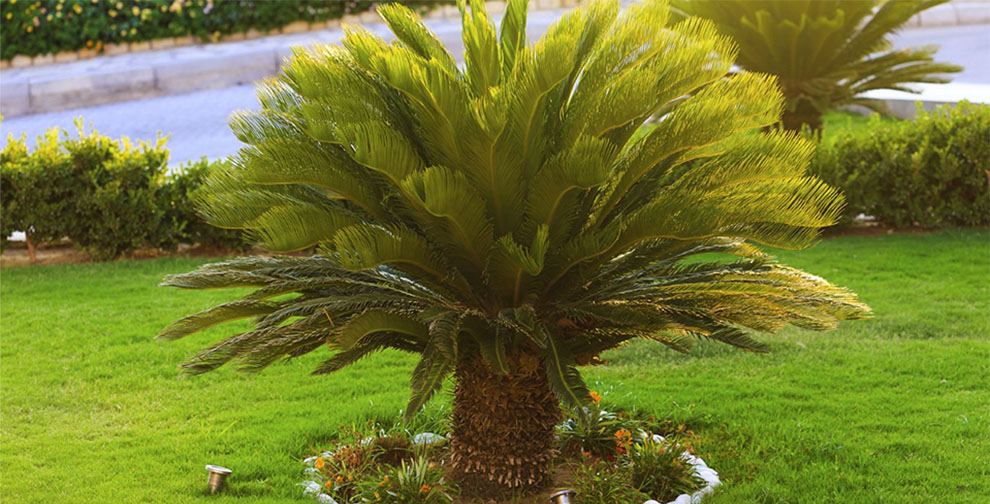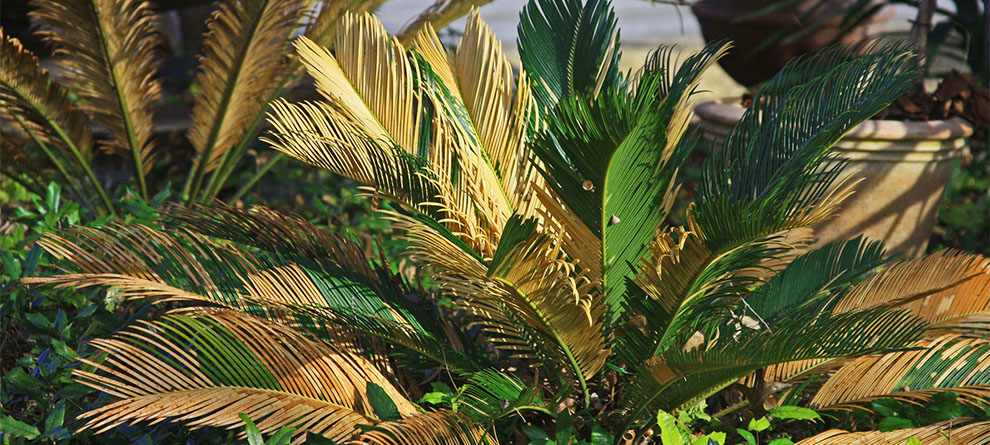Sago Palm Maintenance and Care Tips You Shouldn’t Miss

Do you like having indoor plants in your home or office? Need a plant that has a splendid and exotic look and appeal? Why not consider growing a Sago Palm? It is a forgiving plant. So, Sago Palm maintenance needs are quite low making it a perfect choice for newbies and amateurs with no prior experience with plants.
Botanically known as Cycas Revoluta, Sago Palm is not a true palm. It is a Cycad. Sago is an evergreen, hardy, tropical plant curtailed to sub-tropical and tropical regions. They grow from a trunk and never branch out. Native to Southern China and Japan, Sago has been around since the Mesozoic era. Today, Sago and the other Cycads are found everywhere in the world.
Jump To
- How To Care For Sago Palm Outdoors and Indoors?
- How To Care for Cycas Revoluta Palm Problems?
- Frequently Asked Questions
- Conclusion
Further, their tropical appeal only adds to their desirability as a houseplant. Compared to the pot, the outdoor sago palm will grow taller. In terms of Sago growth, a potted plant reaches 2 to 3 feet in a few years. It will take the plant five decades to get to 10-feet in height.
Broadly, there are three kinds of sago palms:
- King Sago Palm
- Queen Sago Palm
- True Sago Palm
All of these are beautiful, and pretty straightforward to maintain. If you know how to care for sago palm, your plant will thrive well. So, how to take care of a sago palm? This guide below will discuss all the beneficial sago palm care tips. Let us get started and address them one by one.
Sago Palm Growing Conditions

Below, we will discuss the sago palm maintenance guide to help ensure that you expose your plant to the right growing conditions.
1. How deep should you plant a sago palm?
When transplanting a young sago plant, pick a pot slightly wider than its current size. Opt for a container deeper than 16-inches can be particularly helpful as the sago palms enjoy an extra depth for the roots. It is one of the best sago palm care tips.
2. How to plant a sago palm in the ground?
To know how to care for sago palm outdoors, the ground spacing and placement are important. So, outside, the sago palm can grow to about 10-feet. They spread up to 8 feet with fronds of 4 to 5 feet.
It takes Sago about a decade to reach maturity. Hence, during plantation, you need to keep the distance between two plants to ensure that each has ample space to grow and spread. Planting the plants too close to one another can also curtail the airflow.
3. What kind of soil does a sago palm need?
So, how to take care of a sago palm soil requirements? Proper sago palm maintenance requires the right soil selection. Fortunately, sago palms are not very fussy about the soil.
However, they surely need soil with good drainage. So, pick a well-draining soil with a porous potting mix. If the soil is sandy or full of clay, you need compost to cease the deficiency.cease the deficiency.
Also, the soil should have a slightly acidic to neutral pH. A dedicated palm or cactus potting mix, or a combination of pine park, coarse sand, and peat, is suitable for sago.
4. Can sago palms tolerate low light – sunlight requirements?
Sago palms thrive in bright but indirect sunlight. Direct sunlight is not suitable for the sago palms. Also, excessive shade can stunt the plant’s growth. But, if in doubt, give them shade protection.
How to take care of a sago palm plant indoors with light needs?
Generally, you can keep the plant in bright south, west, or east-facing window where they can get ample light. It is one of the quintessential sago palm care tips.
You can also move your indoor plant outdoors in the warm water. The morning and the evening sun suffices the light requirements of the plant. The afternoon sun is harsh and can burn the foliage, especially during the summers.
5. How cold can a Sago Palm tolerate: Ideal temperature needed?
Changing temperatures and how to care for Cycas Revoluta? Sago palms are native to subtropical and tropical regions. Hence, for the plant to thrive, you need to mimic the same temperature. It is quintessential for sago palm maintenance.
Typically, the sago palms enjoy humid and warm weather conditions. So, indoors, if it is comfortable for you, it would be so for your indoor sago palm. The temperature between 65°F (16°C) to 75°F (24°C) is ideal for the plant.
At no time should the temperature go below 55°F (12.7°C). It can kill the plant. So, to maintain sago palm during colder weather, cover your sago with a horticulture sheet or plant or bring it to a warmer spot indoors. Extreme temperature fluctuations can be fatal for the plant.
6. How often do you water a sago palm?
Catering to the plant’s watering requirements is quintessential for proper growth and maintenance. Underwatering and over-watering can have severe implications on the plant. Hence, between two watering frequencies, how to take care of a sago palm?
Check the soil and water it only when the top layer feels dry. Even though they are drought-tolerant, negligence of the water requirements can stunt their growth. Further, the watering frequency during the growing season should be high. You can reduce the frequency in winters.
7. Humidity levels needed by sago palm
Maintaining the requisite humidity levels is also vital for proper sago palm maintenance. Sago palms love high to moderate humidity. Unfortunately, on colder days, the air may be dry. Consequently, the humidity levels may drop. During this time, mist the leaves at least three to four times a week. Alternatively, you can also place the plant on the humidity tray or install a humidifier.
8. What should I feed my sago palm – fertilizer options & fertilizing frequency
Do you ever wonder how to care for Cycas Revoluta if you do not have a rich soil? Well, offering the plant necessary nutrition and feed helps with its maintenance.
During the growing season, fertilizer is a must. You can use a slow-release, water-soluble, liquid fertilizer. Ideally, the fertilizer in 18 (Nitrogen) – 8 (Phosphorous) – 18 (Potassium) ratio is the best.
Different fertilizers have variable directions. So, read the package guidelines, and feed the plant accordingly. Fertilization a week before propagation can help with new growth.
Also, you must water the plant after adding fertilizer. It helps in even spread. Alternatively, watering before the rainy season can also be a good choice.
9. What’s the best way to transplant a sago palm – repotting tips?
Pick the right pot for proper sago palm maintenance. After the selection, you need to place a few inches of gravel at the base. It helps maintain good drainage.
Here are some important tips on how to take care of a sago palm plant when repotting:
- Gently remove the plant from the current pot.
- Keep this extracted plant on a newspaper, and massage its root to access the root ball.
- Now, add soil to the selected pot, and fill it adequately with healthy potting soil with a good mix. The root ball should be just a few inches from the pot’s top.
- Tamp the soil to achieve evenness.
- Now, water the plant till you see the droplets pouring out from the drainage holes.
10. Propagating sago palm
There are two ways of propagation:
- By seeds
- By division
The former requires a lot of effort and time, whereas the latter is more straightforward. So, if you have a friendly neighbor ready to share their baby sago pups, the division should be your preferred method.
You can also find the offsets that resemble baby sago plants from the nursery. Late fall and early spring are the best time for transplantation.
11. Sago palm maintenance guide trimming and pruning
People often think pruning solely helps maintain the aesthetic appeal of the plant. Of course, that is one reason to prune your plants, but the benefits of pruning are two-fold.
Most palms are self-cleaning. It means they voluntarily drop the dead leaves from the plant. However, at times, the dead and dry brown leaves continue sticking to the plant. These stunt the growth and prevent new growth. Hence, it is best to chop them off. Be careful while pruning and cut it close to the trunk once the new leaves have unfurled.
Also, while pruning:
- Use a clean, sharp pair of scissors
- Before using the scissors on the different plants, wipe them clean. It is necessary to ensure that you do not transfer the pests, diseases, and infections from one plant to the other.
- Use dabbing alcohol to wipe clean the scissors.
Related: Palm Lifespan, Palm Growth Rate
How To Tackle Sago Palm Problems? (Diseases/Pests)

Like most other houseplants, even the sago palms are exposed to multiple issues. If left unattended, these can kill the plant. But fortunately, there is a solution to most problems if you know the correct Sago palm care tips.
Here, we will enlist all the prominent sago palm problems with an apt solution to help save your sago palm.
1. Yellowing of The Leaves
The yellowing of sago leaves is a part of the routine life cycle of the plant. If the yellowing seems normal and natural, it requires no remedial action. You do not have to prune or chop them unless they change their color to brown. Unfortunately, most yellow leaves do not return to green.
However, at times, yellowing may be because of:
- Insects
- Manganese deficiency
- Inadequate watering
- Transplant shock
- Root rot
If you can spot the insects causing root rot, use an insecticide or neem oil. However, for sago palm maintenance if magnesium deficiency persists causing yellowing, apply a manganese sulfate powder. To prevent future deficiencies, you can use this powder at least two to three times on the soil.
If the plant appears dull and dry, you are probably not watering it enough. So, water it immediately. Lastly, if the transplant has left the leaves feeling yellow, be attentive, provide necessary growing conditions, and it should recover eventually.
2. Common Pests
Fortunately for indoor gardeners, sago palms do not experience severe diseases or pest-related issues. But, of course, spider mites and scales can be concerning. However, it is easy to ward them off with insecticidal soap. You can also use natural alternatives like neem oil. Good humidity and airflow can prevent any further similar episodes.
3. Black Spots
Often, the plant recovers from pest damage, but the black spots do not vanish. It may be fungus secretions. To overcome this, you need to wash the leaves with water.
4. Root Rotting
Overwatering can cause root rot. Further, poorly drained soil might also result in root rotting. Often, it becomes a breeding ground for the plants and kills the plant from inside.
Keep an eye on your watering frequency, and ensure that the plant is potted in soil with a good potting mix and a well-drainage system. Consider repotting if needed.
Frequently Asked Questions
Ques 1. Are sago palm care tips for indoors any different from outdoors?
Ans. To understand the difference in the palm care tips indoors and outdoors, you need to be thorough with the care requirements in each setup.
How to care for sago palm indoors?
- Sago palms enjoy warm, pleasant weather. But, they do not like full sun. The bright, indirect sunlight will suffice them. Hence, for sago palm maintenance, please keep it away from the window that receives full sun.
- The sago palms enjoy humid conditions. So, if the humidity is low in the air, you must frequently mist the plant or use a humidifier to strike a balance.
- Use fertilizer in the growing season. Opt for a water-soluble, slow-release fertilizer rich in micronutrients.
- Sago palms are toxic for children and pets. Hence, you must keep them away from their reach. Also, while you prune the sago palms, you need to wear gloves.
- Sago palms do not appreciate cold weather. So, how to care for Cycas Revoluta in winters? It helps to move the plant to a warmer spot or group them with other houseplants. Keep the plant away from the door or window that leaks cool air.
- Plant the soil in well-draining soil with rich organic matter. Ensure that the soil is consistently moist.
- After two watering, let the soil dry out.
- Repot once every three years.
How to care for sago palm outdoors?
- One of the most essential sago palm care tips for outdoors is to place the plant in part shade to avoid burning the leaves.
- At all times, the soil should be moist, not soggy. Soggy soil can cause root rot and kill the plant.
- Use a dedicated, slow-release fertilizer during the spring and summer seasons.
- The soil should have good drainage. Since it is hotter outside, the drainage pace should not be very high. You can use sandy soil with rich compost to help retain moisture.
- After maturing, the plant becomes drought-tolerant. Hence, you can reduce watering frequency.
Hopefully, with our tips above, you have clarity on how to care for sago palm indoors and outdoors.
Ques 2. Do sago palms bear flowers?
Ans. Sago palms bloom just once in three or four years. They may bear female or male flowers that look like a cone.
Ques 3. Do sago palms grow well in pots?
Ans. Yes, sago palms are good indoor plants and will grow well in a pot.
Ques 4. Can a yellow leaf turn green again?
Ans. It is the presence of chlorophyll that gives the leaves their green color. So, if the leaf is robbed of chlorophyll, the plant abandons it. Hence, for sago palm maintenance whatever nourishment the leaf receives is from that very leaf.
Therefore, it gets no new nutrition. So, naturally, once the leaf turns yellow, it will most likely never return to green.
Ques 5. Should I cut yellow leaves off the sago palm?
Ans. There is a rare chance for a yellow leaf to go back to green. Over time, these leaves will dry and fall from the plant. But, if you instantly chop them off, you do not give the leaf a chance and cease its growth. Hence, it is advisable to prune only the brown leaves as there is no chance of their reversal.
Ques 6. Do sago palms need sun or shade?
Ans. Sago palms blossom in partial shade and full sun. So, it is convenient to place them in a partially shaded spot.
Ques 7. Are coffee grounds good for sago palms?
Ans. Yes, coffee grounds can be an excellent pest solution for sago palms.
Ques 8. Is sago palm pet safe?
Ans. No, sago palms are poisonous. So, keep these toxic plants away from the reach of pets and children.
Related Care Guides: Areca palm, Date palm, Frosty Fern, Ponytail palm, Majesty palm, Korean Melon
Conclusion
Hopefully, with our guide above, you have the necessary clarity on how to care for sago palm indoors and outdoors. If you follow the sago palm maintenance guide as recommended, your plant will bloom and blossom. Follow these tips on how to care for Cycas Revoluta and have a lush green plant.
